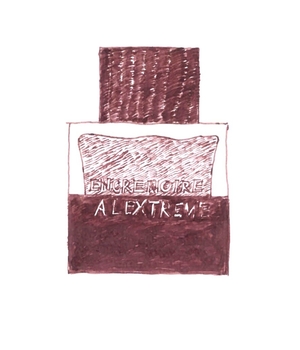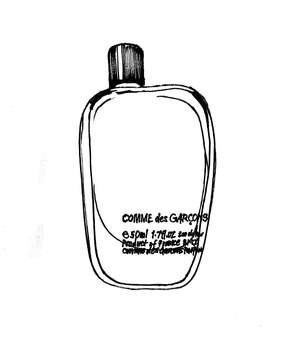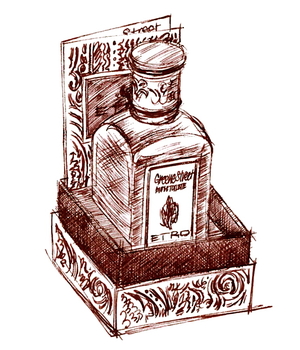Tagged With ‘incense’
Frédéric Malle
Géranium pour Monsieur
28 November, 2016
 The world is full of fresh smells, but only a few of them are widely used in perfumery – mainly the sharp but fruity smells of citrus, which give eau-de-colognes their uplifting zing. The scents of mint or pine-needles are equally fresh and invigorating, yet few people want to smell of either, for the simple reason that mint is so strongly associated with toothpaste, and pine with household cleaning products. It’s a brave perfumer who attempts to use either of them in a fragrance, but Géranium pour Monsieur is a brilliant demonstration of how it can be done.
The world is full of fresh smells, but only a few of them are widely used in perfumery – mainly the sharp but fruity smells of citrus, which give eau-de-colognes their uplifting zing. The scents of mint or pine-needles are equally fresh and invigorating, yet few people want to smell of either, for the simple reason that mint is so strongly associated with toothpaste, and pine with household cleaning products. It’s a brave perfumer who attempts to use either of them in a fragrance, but Géranium pour Monsieur is a brilliant demonstration of how it can be done.
Created by Dominique Ropion for Frédéric Malle in 2009, this is a wonderful alternative to classic colognes, and it also offers something that colognes don’t have: a freshness that lasts not just for a few minutes or an hour or so, but almost all day long. Ropion has cleverly extended the refreshing scent of mint by mixing it with geranium (or rather pelargonium) oil, which has a minty side to it but lasts much longer than mint alone, and a spicy side that is emphasised here with the addition of aniseed, clove oil and cinnamon.
Like all the perfumes that Malle has commissioned for his Editions de Parfums range, this is a rich, complex scent, and its freshness is underlaid with smooth but luxurious ingredients like sandalwood, long-lasting synthetic white musks, and smaller amounts of incense and resinous benzoin. I think it’s a masterpiece, and a fine addition to the wardrobe of any well-dressed man.
Comme des Garçons
Zagorsk
 I’m not sure why, but recently I’ve become a bit obsessed by the smell of pine, and I’ve been seeking out perfumes that feature this fresh, invigorating scent without smelling like toilet cleaner or a Radox bath.
I’m not sure why, but recently I’ve become a bit obsessed by the smell of pine, and I’ve been seeking out perfumes that feature this fresh, invigorating scent without smelling like toilet cleaner or a Radox bath.
Easily the best so far is Zagorsk, from Comme des Garçons’ excellent series of incense-based perfumes, which first went on sale in 2002. Incense has been used in religious ceremonies since time immemorial, and each of the fragrances in the range reflects a different faith: Avignon (another favourite) captures the smell of Catholic cathedrals, while Jaisalmer references Hindu rituals, and Kyoto, the temples of Japan.
Zagorsk, as its name suggests, is inspired by Russia, and the great Orthodox monastery of Sergiyev Posad, north of Moscow, which was known as Zagorsk during Soviet times. Created by perfumer Evelyne Boulanger, it’s a clever and conceptual take on incense, using the smoky elements that you’d expect, but lacing it with the smell of pine and birch – the scent of Russian forests.
What I really like about Zagorsk is the balance between the incense and the pine: one has associations with smoke and warmth and the fug of being inside a church, while the other has the bracing freshness of being outdoors in the snow. So Zagorsk is simultaneously warm and cool, smoky and fresh, which is quite a feat of formulation. It’s also attractive and affordable, so top marks to Comme des Garçons all round.
Lalique
Encre Noire à l’Extrême
18 November, 2016
 Lalique has been associated with perfume since 1907, when its founder, René Lalique, began to produce alluring glass bottles for the prodigiously entrepreneurial French perfumer François Coty. But it wasn’t until 1992 that the company launched a perfume of its own with Lalique de Lalique.
Lalique has been associated with perfume since 1907, when its founder, René Lalique, began to produce alluring glass bottles for the prodigiously entrepreneurial French perfumer François Coty. But it wasn’t until 1992 that the company launched a perfume of its own with Lalique de Lalique.
Encre Noire – literally ‘black ink’ – was released in 2006, and was quickly hailed as one of the best vetiver scents around. Created by the talented perfumer Nathalie Lorson from the Swiss fragrance-and-flavour firm Firmenich, it blends good-quality vetiver (whose earthy, slightly bitter smell comes from the roots of a tropical grass) with the woody notes of cypress and a long-lasting synthetic called Cashmeran, whose effect is as plush as its name.
Though Encre Noire is still available, and presumably a steady seller, Lalique has celebrated its 10th anniversary by launching a slightly more powerful, punchy version called Encre Noire à l’Extrême. Created again by Nathalie Lorson, the new perfume blends two different vetivers, one from Haiti and the from Java, and adds touches of iris, incense, sandalwood and patchouli.
If rather stronger and heavier than the earlier Encre Noire, it’s still a very attractive fragrance, and while Lalique claims that Encre Nore à l’Extrême ‘redefines masculinity’, we feel that it would smell equally appealing on a man or a woman. Think ink.
Comme des Garçons
Avignon
12 July, 2015
 Not everyone wants to smell like a Catholic cathedral in the middle of Midnight Mass, but I do. Maybe it’s because I’m not Catholic, but incense’s associations, for me, are less religious than architectural – and sensual too, since it’s one of those addictively overpowering fragrances that drive you slightly out of your mind (which of course was the original intention).
Not everyone wants to smell like a Catholic cathedral in the middle of Midnight Mass, but I do. Maybe it’s because I’m not Catholic, but incense’s associations, for me, are less religious than architectural – and sensual too, since it’s one of those addictively overpowering fragrances that drive you slightly out of your mind (which of course was the original intention).
The smell of incense is almost certainly among the oldest perfumes we have, with a history that stretches back as far as the word itself – the Latin ‘per fumum’ means ‘through smoke’. The word ‘incense’, meanwhile, derives from ‘incendere’, which also gives us ‘incendiary’ and ‘incinerator’.
Burning incense of one kind or another is common in many ancient cultures around the world, but the Catholic version began life in Africa and the Middle East. Lumps of incense have been found in the tombs of Ancient Egypt, and its main ingredients – frankincense and myrrh – still come from the Yemen, Oman and Somalia.
Recreating the burnt, resinous smell of incense in a perfume must be difficult, but in the last decade several perfumers have made the attempt, and Avignon, to my mind, is among the most convincing. It’s strong stuff, and not everyone will like it, but I love its almost narcotic intensity, with the pungent yet herbaceous smell of sun-burnt shrubs (especially cistus and santolina) on a rocky Greek mountainside. I don’t know if it’s simply the power of association, but I can even detect a hint of the slightly mouldy dampness that so many old churches smell of.
Launched in 2002, Avignon was created for Comme des Garçons by the brilliant French perfumer Bertrand Duchaufour, known for his long-standing association with L’Artisan Parfumeur. The name might seem a bit of a puzzle, until you remember that Avignon – now a beautiful if touristy walled town with tedious suburbs – was the seat of the papacy from 1309 to 1376, after the election of a French pope who refused to move to Rome. And ‘Avignon’ is surely a more evocative and intriguing name for a perfume than ‘Rome’. I, for one, am a willing convert.
Comme des Garçons
Eau de Parfum
12 November, 2014
 Christmas is coming, and as a long-standing fan of over-indulgence I’m thoroughly looking forward to getting fat on Christmas pudding with brandy butter, washed down with a large glass of Harvey’s Bristol Cream, ideally in front of a roaring log fire. Alternatively I could just blow my own socks off with a generous splash of Comme des Garçons’ delicious Eau de Parfum a.k.a. Christmas in a bottle.
Christmas is coming, and as a long-standing fan of over-indulgence I’m thoroughly looking forward to getting fat on Christmas pudding with brandy butter, washed down with a large glass of Harvey’s Bristol Cream, ideally in front of a roaring log fire. Alternatively I could just blow my own socks off with a generous splash of Comme des Garçons’ delicious Eau de Parfum a.k.a. Christmas in a bottle.
Launched in 1994, this was the Japanese cult fashion brand’s first foray into perfume, but if there was nothing unusual about that, it’s rare for a first perfume to make such a big impression. Partly it was the design of the bottle, a slightly egg-shaped oval with an off-centre cap and no obvious way to stand it up.
That might sound a bit annoying, but I think it’s one of the most stylish and sophisticated perfume-bottle designs of the last 20 years. Eccentric it may be, but Comme des Garçons founder Rei Kawakubo’s design is so sleek and refined that it makes most other perfume bottles look cheap and tawdry by comparison.
The Sniff Box is about the scent, though, and what a scent this is. Created by Derby-born perfumer Mark Buxton, it’s not for the shy or faint of heart, for this is one of those fragrances that carries everything (and everyone) before you. The first thing you smell is cloves – or rather clove oil: in fact this is a distinctly oily concoction, for among the other ingredients are nutmeg oil, cinnamon-bark oil, cardamom oil, geranium oil and coriander oil. To me it even feels slightly oily on the skin, which gives it an added touch of luxury and also sets it apart from the vast majority of alcohol-based fragrances.
With ingredients like those it could hardly be anything other than spicy, but Mark Buxton cleverly added a touch of the resinous, smoky smell of incense with cedarwood, labdanum and styrax. The result is wonderfully rich and strange, and though some people find it overpowering, to be overpowered like this is like drowning in a butt of Malmsey: what a way to go!
Etro
Greene Street
26 April, 2014
 The Italian fashion brand Etro made its name with a neo-hippy mix of paisley prints and clashing colours, so it’s no surprise that, among the 25-odd perfumes they’ve released since 1989, there’s the occasional whiff of patchouli and joss-sticks.
The Italian fashion brand Etro made its name with a neo-hippy mix of paisley prints and clashing colours, so it’s no surprise that, among the 25-odd perfumes they’ve released since 1989, there’s the occasional whiff of patchouli and joss-sticks.
Their latest nod in that direction is Greene Street, launched in 2012 to coincide with the opening of their second Manhattan boutique on – you’ve guessed it – Greene Street in SoHo. According to Etro, ‘the western bohemian spirit is the heartbeat of the quarter’, though given that near neighbours include Chanel and Marc Jacobs, Etro’s idea of bohemian may be rather different from yours and mine.
As for the perfume, here’s what they say about it: ‘A symphony of spices create the perfect scent for the modern cosmopolitan man, for those who follow fashion but add their own unique touch of personality to every look. Versatile and distinctive, this perfume also magically adapts a more feminine tone when worn by a woman, thanks to the seductive subtle undertones.’
Got that? Personally I think it smells a bit like that old Body Shop hit from the 1980s, Dewberry, with its slightly choke-inducing mixture of spice and fruitiness. In Greene Street’s case, the scent ingredients include pepper (specifically the ‘pink pepper’ that, in the perfume world, has been so puzzlingly fashionable for the last few years), underpinned with nutmeg, violet and incense, among other things.
I’ve no idea which perfumer created Greene Street, though I see that a number of Etro’s previous fragrances were put together by the French perfume company Robertet; maybe one day we’ll be told, but there again they may be perfectly happy to remain anonymous.
It’s not a horrible perfume, which instantly sets it above most of its competitors on department-store shelves around the world, but neither can I see it becoming one of my favourites. Which is a shame, as much as anything because I think that Greene Street is particularly well packaged and presented.
I haven’t, up to now, included packaging when I’ve illustrated a perfume, but I like this box so much, with its abstract paisley design on the outside and purple inner lining, that I think it’s worth a mention – not least because storing perfumes in their boxes is so much better for them than exposing them to light, and really well-designed packaging is a great encouragement on that front. So two cheers for retro Etro.